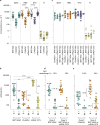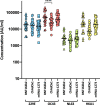SARS-CoV-2 Omicron is an immune escape variant with an altered cell entry pathway
- PMID: 35798890
- PMCID: PMC9352574
- DOI: 10.1038/s41564-022-01143-7
SARS-CoV-2 Omicron is an immune escape variant with an altered cell entry pathway
Erratum in
-
Publisher Correction: SARS-CoV-2 Omicron is an immune escape variant with an altered cell entry pathway.Nat Microbiol. 2022 Oct;7(10):1709. doi: 10.1038/s41564-022-01241-6. Nat Microbiol. 2022. PMID: 36114232 Free PMC article. No abstract available.
Abstract
Vaccines based on the spike protein of SARS-CoV-2 are a cornerstone of the public health response to COVID-19. The emergence of hypermutated, increasingly transmissible variants of concern (VOCs) threaten this strategy. Omicron (B.1.1.529), the fifth VOC to be described, harbours multiple amino acid mutations in spike, half of which lie within the receptor-binding domain. Here we demonstrate substantial evasion of neutralization by Omicron BA.1 and BA.2 variants in vitro using sera from individuals vaccinated with ChAdOx1, BNT162b2 and mRNA-1273. These data were mirrored by a substantial reduction in real-world vaccine effectiveness that was partially restored by booster vaccination. The Omicron variants BA.1 and BA.2 did not induce cell syncytia in vitro and favoured a TMPRSS2-independent endosomal entry pathway, these phenotypes mapping to distinct regions of the spike protein. Impaired cell fusion was determined by the receptor-binding domain, while endosomal entry mapped to the S2 domain. Such marked changes in antigenicity and replicative biology may underlie the rapid global spread and altered pathogenicity of the Omicron variant.
© 2022. The Author(s).
Conflict of interest statement
S.D. declares fees as a Scientific Advisor to the Scottish Parliament on COVID-19. The other authors declare no competing interests.
Figures
















References
-
- WHO SPRP 2021 Mid-term Report – WHO Strategic Action Against COVID 19 (WHO, 2021).
Publication types
MeSH terms
Substances
Supplementary concepts
Grants and funding
- MR/V038613/1/MRC_/Medical Research Council/United Kingdom
- MC_PC_20058/MRC_/Medical Research Council/United Kingdom
- MR/W005611/1/MRC_/Medical Research Council/United Kingdom
- 204721/Z/16/Z/WT_/Wellcome Trust/United Kingdom
- WT109965MA/WT_/Wellcome Trust/United Kingdom
- 211153/Z/18/Z/WT_/Wellcome Trust/United Kingdom
- MC_PC_19026/MRC_/Medical Research Council/United Kingdom
- MR/W02067X/1/MRC_/Medical Research Council/United Kingdom
- MR/R024758/1/MRC_/Medical Research Council/United Kingdom
- MCUU1201412/MRC_/Medical Research Council/United Kingdom
- MC_PC_19027/MRC_/Medical Research Council/United Kingdom
- 107653/Z/15/A/WT_/Wellcome Trust/United Kingdom
- 220977/Z/20/Z/WT_/Wellcome Trust/United Kingdom
- MC_UU_00002/11/MRC_/Medical Research Council/United Kingdom
- MC_UU_12014/12/MRC_/Medical Research Council/United Kingdom
- BB/R019843/1/BB_/Biotechnology and Biological Sciences Research Council/United Kingdom
- MC_UU_12014/2/MRC_/Medical Research Council/United Kingdom
- NIHR300791/DH_/Department of Health/United Kingdom
- BB/R004250/1/BB_/Biotechnology and Biological Sciences Research Council/United Kingdom
LinkOut - more resources
Full Text Sources
Other Literature Sources
Medical
Research Materials
Miscellaneous

